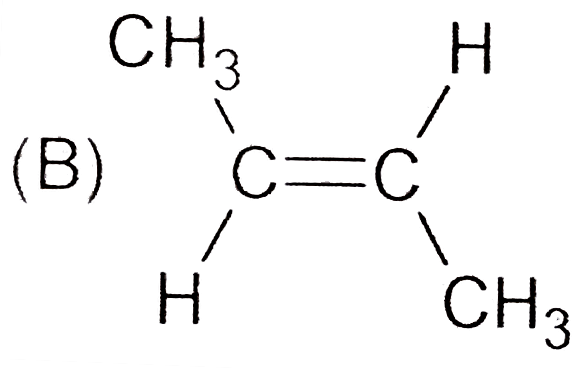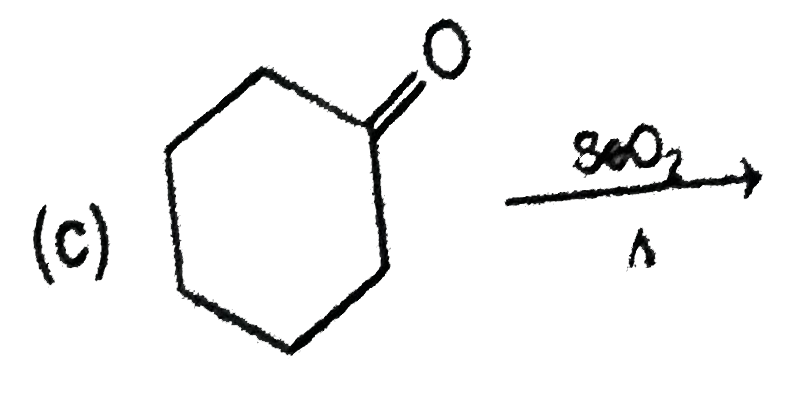CH3−O∣∣C−H+CH3=CH2−ClPPH3/LiCl−−−−−−−→heat'X',X will be


CH3−CH−O−CH3
CH3=OH∣C−CH3−CH3
The correct Answer is:B
To solve the given question, we need to analyze the reaction step-by-step. The reaction involves acetaldehyde (CH₃CHO) reacting with vinyl chloride (CH₂=CHCl) in the presence of a reducing agent (PPh₃) and heat.
1. Identify the Reactants:
- We have acetaldehyde: CH₃CHO
- We have vinyl chloride: CH₂=CHCl
2. Recognize the Reaction Type:
- The reaction is a nucleophilic addition where the carbonyl carbon of acetaldehyde acts as an electrophile and the double bond of vinyl chloride acts as a nucleophile.
3. Nucleophilic Attack:
- The nucleophile (vinyl chloride) attacks the electrophilic carbonyl carbon of acetaldehyde. This leads to the formation of a tetrahedral intermediate.
4. Formation of the Intermediate:
- The tetrahedral intermediate can be represented as:
CH₃C(OH)(CH₂=CHCl)
- Here, the chlorine atom (Cl) is a good leaving group, and it will leave the intermediate.
5. Elimination of Chlorine:
- The leaving of Cl⁻ will lead to the formation of an alkene. The resulting compound after the elimination of Cl will be:
CH₃C(CH₂=CH)O
6. Reduction with PPh₃:
- The presence of PPh₃ indicates that we will reduce the carbonyl group (C=O) to an alcohol (C-OH). Thus, we will convert the carbonyl to an alcohol:
CH₃C(CH₂=CH)OH
7. Tautomerization:
- The alcohol can undergo tautomerization, where the hydrogen from the alcohol group can shift to the adjacent carbon, resulting in the formation of an enol:
CH₂=CHC(OH)CH₃
8. Final Product:
- The final product 'X' can be represented as:
CH₂=CHC(OH)CH₃
- This compound is 3-buten-2-ol.
Conclusion:
The product 'X' formed from the reaction is 3-buten-2-ol.
- We have acetaldehyde: CH₃CHO
- We have vinyl chloride: CH₂=CHCl
- The reaction is a nucleophilic addition where the carbonyl carbon of acetaldehyde acts as an electrophile and the double bond of vinyl chloride acts as a nucleophile.
- The nucleophile (vinyl chloride) attacks the electrophilic carbonyl carbon of acetaldehyde. This leads to the formation of a tetrahedral intermediate.
- The tetrahedral intermediate can be represented as:
CH₃C(OH)(CH₂=CHCl)
- Here, the chlorine atom (Cl) is a good leaving group, and it will leave the intermediate.
- The leaving of Cl⁻ will lead to the formation of an alkene. The resulting compound after the elimination of Cl will be:
CH₃C(CH₂=CH)O
- The presence of PPh₃ indicates that we will reduce the carbonyl group (C=O) to an alcohol (C-OH). Thus, we will convert the carbonyl to an alcohol:
CH₃C(CH₂=CH)OH
- The alcohol can undergo tautomerization, where the hydrogen from the alcohol group can shift to the adjacent carbon, resulting in the formation of an enol:
CH₂=CHC(OH)CH₃
- The final product 'X' can be represented as:
CH₂=CHC(OH)CH₃
- This compound is 3-buten-2-ol.
The product 'X' formed from the reaction is 3-buten-2-ol.
Similar Questions
Knowledge Check
- Question 1 - Select One
CH3CH2CH2−O∣∣C−H+CH3−C≡ChNa,NH3(l)−−−−−−−→
A B
B C
C D
D
- Question 2 - Select One
Arrange the following compounds in decreasing order of nucleophilic addition reaction:
CH3−O∣∣CI−CH3 CH3−O∣∣CII−Cl CH3−O∣∣CIII−NH2 CH3−O∣∣CIV−OH
CH3−O∣∣C−OV−O∣∣C−CH3AII>V>I>IV>IIIBIII>IV>I>V>IICII>I>V>III>IVDI>III>V>I>II - Question 3 - Select One
CH3−CH=CH2Br2−−−−−−−−→h v (low conc.)Mg−−−−−→Dry etherCH3−O∣∣C−CH3−−−−−−−−−→NH4ClH+−−→Δ(X)(major)
End product (X) of the above reaction is :ACH2=CH−CH2−CH2∣∣C−CH3BH2C=CH−CH=C∣CH3−CH3CH2C=CH−CH2−OH∣C∣CH3−CH3DH2C=CH−CH2−CH−CH2∣CH3−OH
Complete the following
(a) CH3−CHOSeO2−−→Δ, (b) H3C−CH2−O∣∣C−CH3SeO2−−→Δ, (c) View Solution
View SolutionCH3−CH3∣CH−CH2−CH2C∣∣O−CH+3H2/Pd/C−−−−−−→ No. of stereoisomerism. Find the number.
View SolutionCH3−O∣∣C−CH3Conc−−−→HNO3 Product
The product is
View SolutionCH3−CH3∣CH−NO2NaNO2+H2SO4−−−−−−−−−−−−→at0∘C(A). (A) is:
View SolutionCH3−CH=CH2BD3−−−−−−−→H2O2/OH−product X, X is :
View Solution

